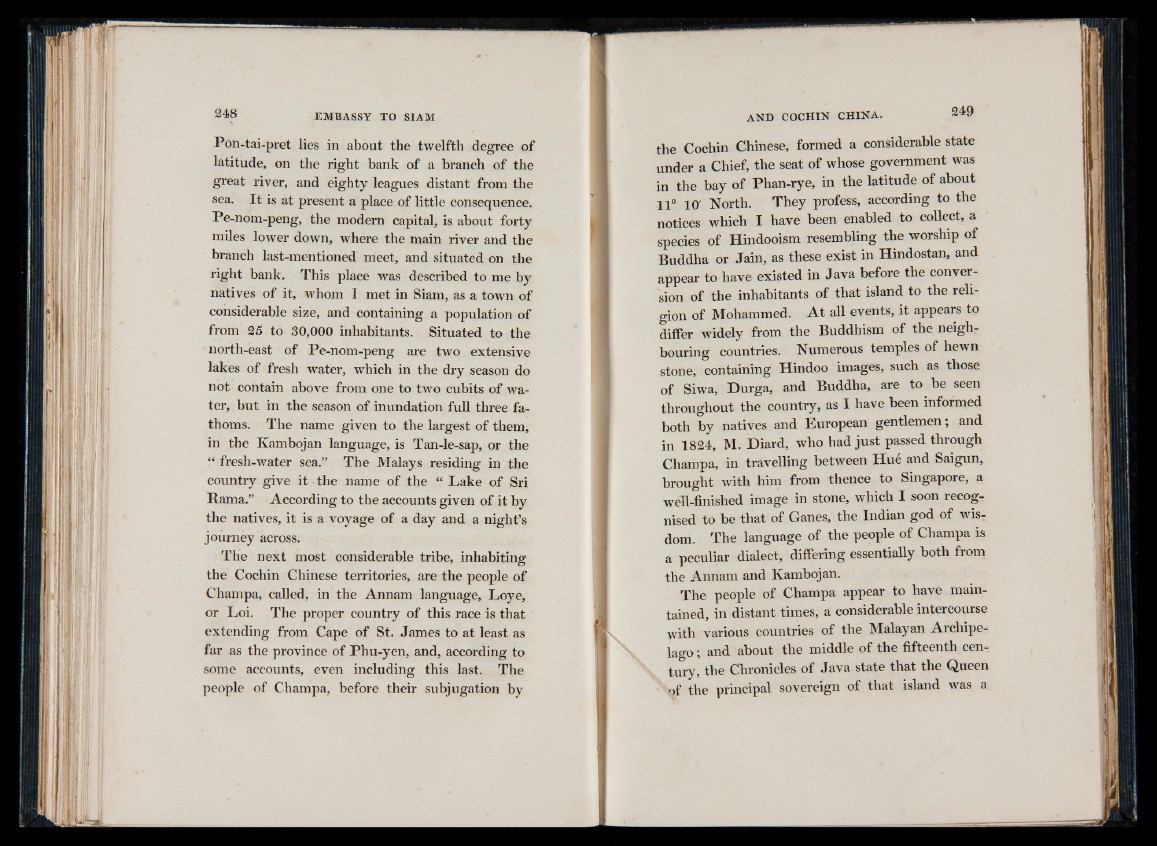
Pon-tai-pret lies in about the twelfth degree of
latitude, on the right bank of a branch of the
great river, and eighty leagues distant from the
sea. I t is at present a place of little consequence.
Pe-nom-peng, the modern capital, is about forty
miles lower down, where the main river and the
branch last-mentioned meet, and situated on the
right bank. This place was described to me by
natives of it, whom I met in Siam, as a town of
considerable size, and containing a population of
from 25 to 30,000 inhabitants. Situated to the
north-east of Pe-nom-peng are two extensive
lakes of fresh water, which in the dry season do
not contain above from one to two cubits of water,
but in the season of inundation full three fathoms.
The name given to the largest of them,
in the Kambojan language, is Tan-le-sap, or the
“ fresh-water sea.” The Malays residing in the
country give it the name of the “ Lake of Sri
Rama.” According to the accounts given of it by
the natives, it is a voyage of a day and a night’s
journey across.
The next most considerable tribe, inhabiting
the Cochin Chinese territories, are the people of
Champa, called, in the Annam language, Loye,
or Loi. The proper country of this race is that
extending from Cape of St. James to at least as
far as the province of Phu-yen, and, according to
some accounts, even including this last. The
people of Champa, before their subjugation by
the Cochin Chinese, formed a considerable state
under a Chief, the seat of whose government was
in the bay of Phan-rye, in the latitude of about
11° 10' North. They profess, according to the
notices which I have been enabled to collect, a
species of Hindooism resembling the worship of
Buddha or Jain, as these exist in Hindostán, and
appear to have existed in Java before the conversion
of the inhabitants of that island to the religion
of Mohammed. A t all events, it appears to
differ widely from the Buddhism of the neighbouring
countries. Numerous temples of hewn
stone, containing Hindoo images, such as those
of Siwa, Durga, and Buddha, are to be seen
throughout the country, as I have been informed
both by natives and European gentlemen; and.
in 1824, M. Diard, who had just passed through
Champa, in travelling between Hué and Saigun,
brought with him from thence to Singapore, a
well-finished image in stone, which I soon recognised
to be that of Ganes, the Indian god of wisdom.
The language of the people of Champa is
a peculiar dialect, differing essentially both from
the Annam and Kambojan.
The people of Champa appear to have maintained,
in distant times, a considerable intercourse
with various countries of the Malayan Archipelago
; and about the middle of the fifteenth cen-
the Chronicles of Java state that the Queen
\ o f the principal sovereign of that island was a